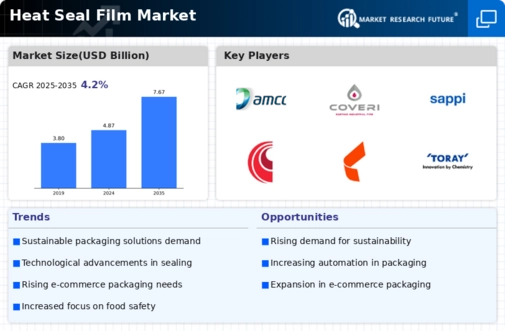Growth in E-commerce and Online Retail
The expansion of e-commerce and online retail platforms is significantly influencing the Heat Seal Film Market. As more consumers opt for online shopping, the need for effective packaging solutions that ensure product safety during transit has become paramount. Heat seal films are increasingly utilized in packaging to provide tamper-proof seals and protect products from external elements. Recent statistics indicate that e-commerce sales are expected to reach over 6 trillion dollars by 2024, which underscores the necessity for robust packaging solutions. This trend compels manufacturers to innovate and produce heat seal films that meet the rigorous demands of e-commerce logistics.
Technological Innovations in Packaging
Technological advancements in packaging materials are reshaping the Heat Seal Film Market. Innovations such as biodegradable films and multi-layered structures are gaining popularity as manufacturers seek to improve product performance and sustainability. These advancements not only enhance the functionality of heat seal films but also align with the growing consumer demand for eco-friendly packaging solutions. The market for sustainable packaging is anticipated to grow significantly, with projections indicating a potential increase of 7% annually. This trend encourages manufacturers to invest in research and development to create heat seal films that meet both performance and environmental standards.
Rising Demand for Convenience Packaging
The increasing consumer preference for convenience packaging is a notable driver in the Heat Seal Film Market. As lifestyles become busier, consumers are gravitating towards products that offer ease of use and portability. This trend is reflected in the food and beverage sector, where ready-to-eat meals and single-serve packages are gaining traction. According to recent data, the convenience food segment is projected to grow at a compound annual growth rate of approximately 4.5% over the next five years. Consequently, manufacturers are focusing on developing heat seal films that enhance product shelf life while maintaining freshness, thereby catering to this evolving consumer demand.
Increased Focus on Food Safety Regulations
The heightened emphasis on food safety regulations is a critical driver for the Heat Seal Film Market. Governments and regulatory bodies are implementing stringent guidelines to ensure food quality and safety, which directly impacts packaging materials. Heat seal films are favored for their ability to create airtight seals that prevent contamination and extend shelf life. As a result, manufacturers are investing in advanced heat seal film technologies that comply with these regulations. The market for food packaging is projected to grow at a rate of 5% annually, driven by these regulatory changes, thereby enhancing the demand for high-quality heat seal films.
Rising Demand in the Pharmaceutical Sector
The pharmaceutical sector's increasing demand for secure and sterile packaging is a vital driver in the Heat Seal Film Market. As the need for safe drug delivery systems grows, heat seal films are being utilized for their ability to provide tamper-evident and moisture-resistant packaging. This is particularly important for sensitive medications that require stringent storage conditions. The pharmaceutical packaging market is expected to witness a growth rate of approximately 6% over the next few years, which is likely to bolster the demand for specialized heat seal films. Manufacturers are thus focusing on developing films that cater specifically to the unique requirements of the pharmaceutical industry.





















Leave a Comment